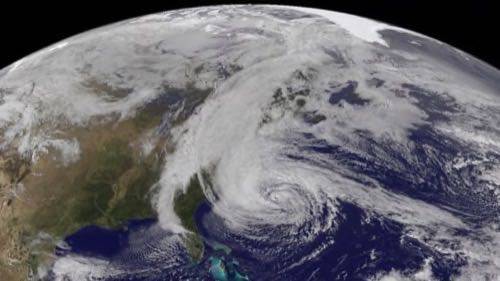
As Hurricane Sandy bears down on the U.S. East Coast, the high concentration of the country’s Internet infrastructure in the path of the Category 1 storm means it is reasonable to expect potential outages of Internet and web sites through the next few days. But which providers and connections are most at risk?
(See Also: Preparing Your Smartphone – And Yourself – For Hurricane Sandy)
Sandy is expected, as midday Monday, to make landfall somewhere near Atlantic City, NJ sometime Monday evening. Though the storm is officially classified as Category 1 (maximum sustained winds from 74-95 mph), there’s no escaping the fact that this is one large storm: according to Dr. Jeff Masters at Wunderground.com, “Sandy’s tropical storm-force winds span an area of ocean 940 miles in diameter.”
Internet Exchanges Threatened
With such a massive footprint, there is very little on the East Coast that won’t be touched by Sandy in the next few days. Of particular interest to business and commerce is the status of their websites. Due to the positioning of six Internet exchanges in the vicinity of Sandy, many datacenters and cloud service providers could be potentially knocked out by the effects of the storm.
If you have ever wondered why there are so many cloud service providers in the Washington, DC, area, you can thank the Equinix Exchange in Ashburn, VA, an Internet exchange that ranks the DC area as 11th in the world for traffic, according to TeleGeography.com. The DC Metro area is on the very southern edge of the latest forecast track for Sandy, and even an indirect hit here could affect cloud service providers hosting thousands of websites.
Nearby Reston, VA, for instance, is home to datacenters owned by Iland Cloud Infrastructure, Sevtex, VPS Farm and one you may have heard of: Amazon Web Services, which handles high-profile websites such as Netflix, Pinterest and Heroku.
Ashburn itself is home to one of GoGrid’s datacenters, and in Washington, DC lives mega-hosting service SoftLayer CloudLayer.
Farther up the Atlantic coast, the New York metro area (ranked 5th in world Internet traffic) has five Internet exchanges, and cloud providers like Linode, cloud3k, and Atlantic Metro are also based in the area. (See the end of the article for a complete list of cloud servicer providers as gathered from Data Center Map.)
Prep Time Is Critical
Fortunately, given the amount of time that these cloud providers and their customers have had to prepare for the onslaught of the storm, connectivity should be maintained for sites using these service providers. But individual businesses who host on-site in the area will have to rely on their own plans to maintain power and connection.
Based on the path of the storm, the New York and northern New Jersey datacenters would seem to be at the most risk right now, as high winds, local flooding and sustained power problems could eventually overwhelm any uninterrupted-power scenarios a provider could think of. If the Internet exchanges themselves go down, the effect on commercial and personal Internet traffic would be significant, and could cause problems for any emergency services relying on Internet communication to broadcast information to area residents.
With luck, Internet connectivity will be maintained, and online business will carry on. This will be the largest reliability and survivability test telecomm and Internet providers have had to face in a long time, how they prepared will make a big difference in whether they pass or fail.
Cloud Service Providers In Path Of Sandy
Delaware
Wilmington: IPR International
District of Columbia
Washington: SoftLayer CloudLayer
Maryland
Baltimore: OCOSA Cloud
New Jersey
Hudson County: Atlantic Metro vCLOUD
Newark: Linode
North Bergen: Atlantic Metro vCLOUD
Piscataway: cloud3k
Secaucus: infiniCloud logicworks
New York
New York: Atlantic Metro vCLOUD, Inerail, infiniCloud logicworks, Qube Virtual Data Center
Pennsylvania
Bethlehem: dbsi
Breinigsville: dbsi
Philadelphia: dbsi
Reading: IPR International
Virginia
Ashburn: GoGrid
Culpepper: Terremark Worldwide, Inc.
Reston: Amazon EC2, Iland Cloud Infrastructure, Sevtex, VPS Farm LLC
Vienna: Open Hosting
Internet Exchange Centers in Path of Sandy
Ashburn, VA: EQIX-ASH Equinix Exchange Ashburn
New York, NY: Big-APE The Big Apple Peering Exchange, EQIX-NYC (Equinix Exchange New York), NYIIX (New York International Internet eXchange), PAIX-NYC (Peering And Internet eXchange New York), TIE-NYC (Telx Internet Exchange New York)
Image Courtesy of NASA









